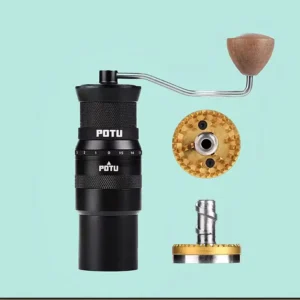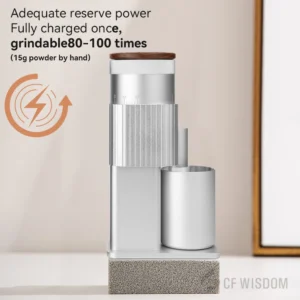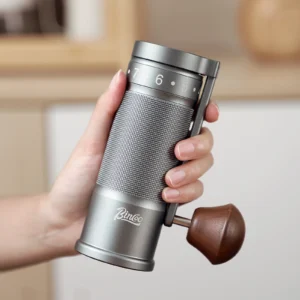Understanding the Science of Coffee Grinding
The journey to a perfect cup of coffee begins long before hot water touches your grounds. The grinding process fundamentally determines how flavors will be extracted from your beans. When we grind coffee, we’re essentially creating more surface area for water to interact with, allowing the soluble compounds—the elements that create flavor—to dissolve into your brew.
Particle size uniformity stands as perhaps the most critical factor in achieving balanced flavor. When coffee grounds are consistent in size, water extracts flavor compounds at a similar rate from each particle. This uniformity leads to balanced extraction and harmonious flavor.
Surface area is the key concept here. Consider this: one gram of finely ground coffee has significantly more surface area exposed to water than one gram of coarsely ground coffee. This difference in surface area directly impacts how quickly and completely flavor compounds dissolve.
When we talk about “flavor extraction” in coffee brewing, we’re referring to the process where water dissolves the soluble compounds in coffee grounds. These include:
- Acids (responsible for brightness and fruit-like qualities)
- Sugars (providing sweetness and body)
- Caffeine (contributing bitterness)
- Aromatic oils (delivering complex aromas and flavors)
The consequences of inconsistent grinds are immediately apparent in your cup:
– Under-extraction from large, inconsistent particles produces sour, weak coffee lacking depth
– Over-extraction from too many fine particles creates bitter, harsh flavors that overwhelm subtlety
The ideal extraction percentage falls between 18-22% of the coffee’s mass. Outside this range, unpleasant flavors dominate. Understanding these principles helps explain why precise grind settings for espresso are so crucial to achieving balanced shots with proper extraction.
Burr Grinders: Construction and Mechanics
Unlike blade grinders that haphazardly chop beans with rapidly spinning blades (creating wildly inconsistent particle sizes), burr grinders crush coffee beans between two abrasive surfaces with precision. This fundamental difference in approach—cutting versus crushing—explains why burr grinders produce significantly more consistent grounds.
The basic components of a burr grinder include:
- Two burrs (grinding surfaces)—one stationary and one rotating
- An adjustment mechanism to control the distance between burrs
- A motor or hand-crank mechanism
- A hopper for beans
- A collection chamber for ground coffee
As coffee beans enter the grinding chamber, they’re funneled between the burrs, where they’re progressively crushed into smaller particles. The distance between the burrs determines the final particle size—closer burrs produce finer grounds, while more distant burrs create coarser grounds.
“Burr geometry” encompasses more than simple diameter—it includes the shape, depth, and pattern of the cutting teeth, the angle of the cutting surfaces, and how beans move through the grinding path. These elements collectively determine how efficiently and consistently beans are ground.
Materials matter too. Steel burrs offer sharp cutting edges and durability, while ceramic burrs resist heat buildup but may be more brittle. High-quality manual coffee burr grinders typically feature precision-machined burrs made from hardened steel or ceramic that maintain their edge over time.
The Significance of Burr Size: Beyond Simple Diameter
When coffee professionals discuss “burr size,” they’re referring to a constellation of factors including diameter, surface area, and the design of the cutting surface. While a larger diameter is often associated with better grinding, the relationship is more nuanced.
Larger burrs typically offer more precise particle distribution for several reasons:
- Greater cutting surface means beans are ground more gradually
- More cutting teeth engage with beans simultaneously
- The grinding path is longer, resulting in more consistent breakdown
- Heat generation is distributed across a larger surface area
The relationship between burr diameter and grinding speed is direct—larger burrs process coffee more quickly because more beans can be ground simultaneously. For example, a 60mm burr set might grind 2-3 grams per second, while a 38mm set might only manage 0.5-1 gram in the same time.
Burr size also directly impacts motor requirements. Larger burrs create more resistance and require more torque to operate effectively. This is why smaller burrs are common in home grinders, while commercial machines feature much larger grinding surfaces.
Heat generation is another crucial factor. Coffee’s volatile flavor compounds are sensitive to heat, which can prematurely extract or alter delicate flavors. Larger burrs typically generate less heat per gram of coffee because:
– They require fewer rotations to grind the same amount
– The heat is distributed across a larger surface area
– They often operate at lower RPMs
Understanding the definitive relationship between coffee burr size and uniformity helps coffee enthusiasts make informed decisions about grinder selection for their brewing needs.
Typical burr sizes across different categories include:
– Home grinders: 1.5-2.4 inches (38-60mm)
– Prosumer grinders: 2.3-3.0 inches (58-75mm)
– Commercial grinders: 3.1-4.0+ inches (80-100+mm)
Particle Distribution: The Key Metric for Grind Quality
Particle Size Distribution (PSD) is the technical term for measuring how uniform coffee grounds are. A narrow PSD means most particles are similar in size—the ideal for even extraction. A wide PSD indicates inconsistency, which leads to extraction problems.
Coffee grind distributions typically fall into two categories:
– Unimodal: Most particles cluster around a single size (preferred for filter methods)
– Bimodal: Particles cluster around two different sizes (sometimes preferred for espresso)
The presence of “fines”—tiny particles much smaller than the target grind size—significantly impacts extraction. These microscopic grounds extract very quickly, often contributing bitter compounds that can overpower other flavors. High-quality burrs, particularly those found in premium flat burr hand grinders, minimize the production of fines.
At the other extreme, “boulders” (abnormally large particles) resist extraction, contributing little flavor and creating imbalance. These under-extracted particles produce hollow, sour notes that detract from the coffee’s potential complexity.
The relationship between burr size and particle distribution is generally proportional—larger, well-designed burrs typically produce more consistent particles with fewer outliers. This consistency directly translates to more even extraction and better flavor clarity in the cup.
In technical terms, ideal particle sizes vary by brewing method:
– Espresso: 200-400 microns
– Pour-over: 500-900 microns
– French Press: 800-1200 microns
A quality grinder will produce a tight cluster around these target ranges rather than a wide spread of sizes.
Comparing Flat and Conical Burrs: Design Impact on Flavor
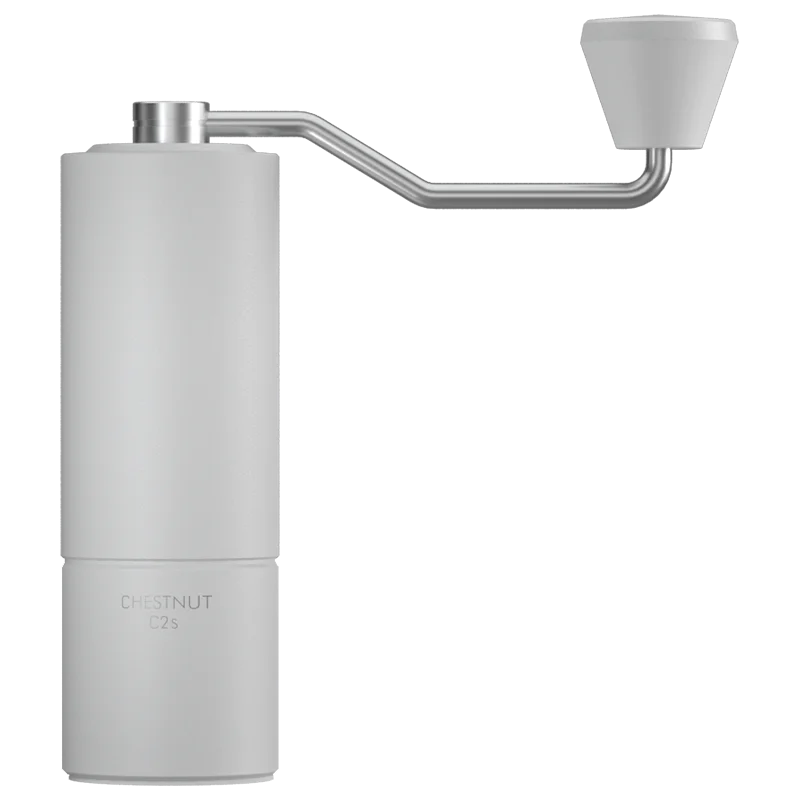
The debate between flat and conical burrs represents one of coffee’s most enduring discussions. These fundamentally different designs approach the grinding task with distinct geometries that influence flavor outcomes.
| Characteristic | Flat Burrs | Conical Burrs |
|---|---|---|
| Grinding Path | Shorter, more direct | Longer, more gradual |
| Particle Distribution | More unimodal | Slightly more bimodal |
| Heat Generation | Generally higher | Generally lower |
| Flavor Profile | Clarity, brightness, articulation | Body, richness, complexity |
| Ideal Applications | Light-medium roasts, filter brewing | Medium-dark roasts, espresso |
Flat burrs feature two parallel rings with teeth that face each other. As beans pass between these surfaces, they’re crushed in a relatively direct path. This design tends to produce highly uniform particle sizes with fewer fines, resulting in clear, distinct flavor notes with pronounced acidity and brightness.
Conical burrs consist of a cone-shaped burr fitting inside a ring-shaped burr. This creates a more gradual grinding path where beans are broken down progressively. The resulting grind typically includes a small but deliberate percentage of fines, which many espresso enthusiasts appreciate for contributing body and richness.
Size variations within each type further complicate the picture. Large flat burrs (75mm+) offer exceptional uniformity ideal for showcasing delicate flavor notes. Small conical burrs (38-50mm) are compact and efficient but may produce less consistent results than their larger counterparts.
Understanding the distinct characteristics of flat vs. conical burr manual grinders helps coffee enthusiasts select equipment that matches their flavor preferences and brewing methods.
Burr Size and Flavor: Direct Correlations in the Cup
The connection between burr characteristics and flavor outcomes is direct and profound. Larger, more precise burrs generally enhance flavor clarity by creating more uniform extraction conditions. When particles extract at similar rates, distinct flavor notes become more recognizable and articulated in the cup.
Consistent particle size dramatically improves extraction balance by allowing water to extract soluble compounds from grounds at similar rates. This balanced extraction reveals the full spectrum of desirable flavor compounds while minimizing the extraction of harsh, bitter elements.
Different burr designs excel at highlighting specific coffee characteristics:
• Flat burrs often enhance:
– Clarity and transparency of flavor
– Bright, vibrant acidity
– Distinct, articulate flavor notes
– Floral and fruit-forward characteristics
• Conical burrs frequently emphasize:
– Body and mouthfeel
– Chocolatey, nutty notes
– Sweetness and richness
– Complex, layered flavor profiles
The precision of burr manufacturing directly affects how clearly a coffee’s intrinsic qualities express themselves. Well-made burrs found in precision manual grinders produce grounds that allow specific flavor compounds to be extracted in proper proportion. This precision particularly influences the balance between acidity (which contributes brightness and liveliness) and sweetness (which provides depth and roundness).
Specialty coffee origins often respond differently to various burr types. Ethiopian coffees, known for their delicate floral notes, frequently shine with flat burrs that enhance clarity. Conversely, Brazilian coffees, prized for chocolate and nut characteristics, may benefit from conical burrs that emphasize body and sweetness.
Optimizing Burr Selection for Different Brewing Methods
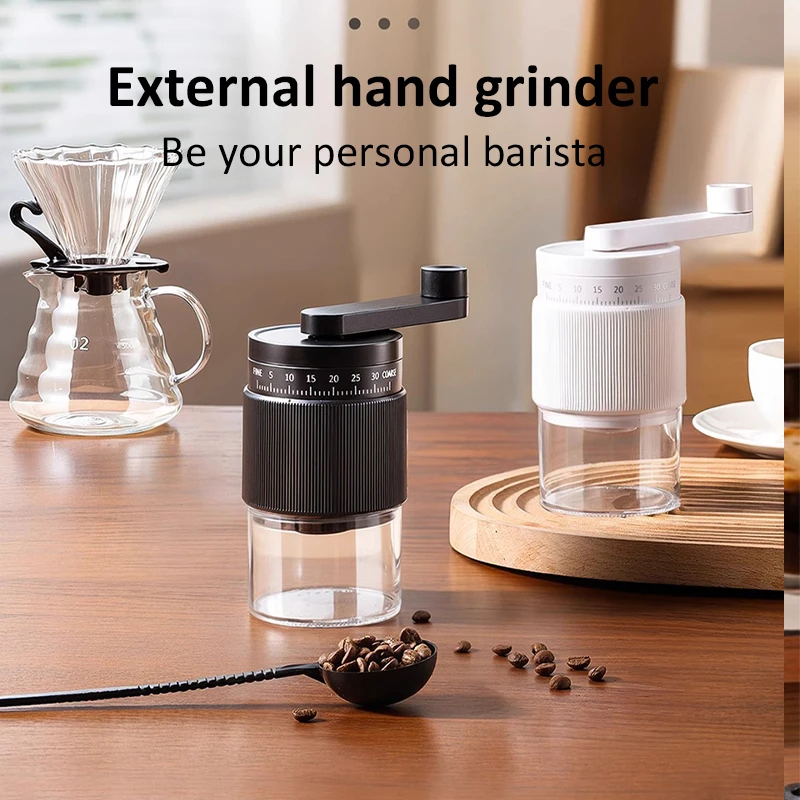
Different brewing methods extract coffee under vastly different conditions—pressure, time, temperature, and water flow all vary significantly. These variations mean that each method benefits from specific grind profiles and, by extension, particular burr characteristics.
For espresso preparation, ideal burr characteristics include:
– Precisely machined burrs with minimal manufacturing tolerances
– Burrs capable of fine, consistent grinding (200-400 microns)
– Design that produces a small percentage of fines for body and crema
– Larger diameter burrs (58mm+) for reduced heat generation
Many espresso enthusiasts find that knowing how to adjust espresso grind size for optimal extraction is essential for pulling consistent shots with balanced flavor profiles.
Pour-over and filter methods benefit from:
– Burrs producing highly uniform particles (500-900 microns)
– Minimal fines production for clean, clear cup profile
– Flat burrs that emphasize clarity and brightness
– Precise adjustment mechanisms for small incremental changes
Immersion brewing methods like French press and cold brew prefer:
– Burrs capable of consistent coarse grinding (800-1200 microns)
– Designs that minimize fines (which can lead to sludge)
– Burrs that emphasize sweetness and body
– Sturdy construction to handle the resistance of coarse grinding
The key to success is matching your primary brewing method with a grinder whose burr design complements that method’s extraction dynamics. Many coffee enthusiasts eventually acquire multiple grinders optimized for different brewing approaches.
Fine Adjustment Hand Grinder, Precision Manual Grinder, Travel Coffee Grinder
Price range: $185.11 through $494.63 Select options This product has multiple variants. The options may be chosen on the product pageHand Burr Grinder, Hand Crank Coffee Grinder, Manual Espresso Grinder, Portable Coffee Grinder
Price range: $262.72 through $300.22 Select options This product has multiple variants. The options may be chosen on the product pageManual Burr Mill, Manual Coffee Grinder Stainless Steel, Manual Coffee Mill Grinder, Mechanical Coffee Grinder
Price range: $127.26 through $130.32 Select options This product has multiple variants. The options may be chosen on the product pageHand Burr Grinder, Manual Coffee Grinder Stainless Steel, Precision Manual Grinder
Price range: $183.64 through $187.52 Select options This product has multiple variants. The options may be chosen on the product page
Factors Beyond Size: Other Burr Variables Affecting Flavor
While size receives most attention, several other burr variables significantly impact grinding performance and flavor outcomes. Burr alignment ranks among the most critical—even perfectly designed burrs perform poorly if improperly aligned. When burrs run parallel and concentric, they produce consistent grounds. When misaligned, they create uneven particles and excessive fines.
Burr sharpness fundamentally determines grinding efficiency and heat generation. New burrs cut cleanly through coffee beans, while worn burrs crush and tear, creating more friction, heat, and inconsistent particles. Premium grinders typically feature burrs rated to process 1,000-2,000 pounds (450-900 kg) of coffee before requiring replacement.
Motor speed (measured in RPM) directly influences heat generation. Higher speeds create more friction and heat, potentially altering delicate flavor compounds. Many high-end grinders incorporate lower RPM motors with higher torque to minimize heat while maintaining grinding efficiency.
“Seasoning” new burrs—running several pounds of coffee through them before brewing—helps smooth microscopic manufacturing burrs and improves particle consistency. This process can noticeably enhance flavor clarity as burrs reach their optimal performance state.
Material differences between steel and ceramic burrs create distinct performance characteristics. Steel burrs are typically sharper and more durable but conduct heat more readily. Ceramic burr coffee grinders resist heat transfer and maintain sharpness well but are more susceptible to damage from foreign objects like stones occasionally found in coffee beans.
Signs of burr wear include increasing difficulty maintaining consistent grind size, more fines production, and slower grinding performance. Regular cleaning and inspection help maintain optimal performance throughout a burr’s lifespan.
Practical Implications: Choosing a Grinder Based on Burrs
When evaluating grinder specifications, burr quality should be your primary consideration—even above motor power or aesthetic design. Look for manufacturers who provide detailed information about burr material, diameter, manufacturing process, and alignment mechanisms.
Investing in quality burrs pays dividends over time. While premium grinders command higher prices, their superior extraction capabilities enhance every cup you brew, maximizing the value of your coffee beans. A $20 difference in coffee bean quality is noticeable, but a $200 difference in grinder quality can transform even average beans into exceptional brews.
When balancing budget against performance, prioritize these burr characteristics:
– Material quality and manufacturing precision
– Alignment stability and adjustment mechanisms
– Size appropriate for your primary brewing method
– Reputation for consistency and durability
Matching grinder capabilities to brewing needs ensures optimal results. For espresso lovers, precise adjustability and fine grinding capability are non-negotiable. For those who primarily brew pour-over coffee, uniform particle size across medium grind settings becomes the priority.
Understanding different espresso grind size requirements helps users get the most from their equipment, regardless of burr configuration. Regular maintenance—cleaning burrs of oil buildup and recalibrating as needed—preserves performance and extends equipment life.
Advanced Grinding Techniques: Maximizing Burr Performance

Single-dosing—grinding only what you need for immediate use—represents the pinnacle of precision brewing. This approach eliminates stale grounds and ensures maximum freshness with each extraction.
To implement effective single-dosing:
1. Measure your exact dose of whole beans (typically 15-20g for espresso, 20-30g for filter)
2. Add beans to an empty hopper
3. Grind completely, ensuring all grounds are dispensed
4. Gently tap the grinder to dislodge retained grounds
5. Transfer directly to your brewing device
Many professional baristas employ the Ross Droplet Technique (RDT)—adding a tiny amount of water (just a few drops) to beans before grinding. This minimal moisture reduces static charge that causes grounds to cling to surfaces and reduces “popcorning” of beans, improving grind consistency.
Bean temperature significantly impacts grinding performance. Cooler beans produce more fines, while room-temperature beans grind more consistently. For optimal results, allow refrigerated beans to reach room temperature before grinding.
As coffee ages, it becomes drier and more brittle, requiring progressively finer grind settings to achieve proper extraction. Understanding how to adjust espresso grind settings for perfect shots as beans age helps maintain consistent flavor despite the natural aging process.
To minimize retention in burr chambers—grounds that remain trapped between uses—many enthusiasts employ techniques like gentle tapping, using compressed air, or even specialized distribution tools to ensure complete dispensing of grounds.
The Future of Burr Design: Innovations and Research
The coffee industry continues to advance burr technology through innovative designs and materials. Recent developments include titanium nitride coatings that improve durability and reduce friction, and specialized treatments that maintain sharp cutting edges for longer periods.
Computational modeling of particle distribution has revolutionized burr design, allowing manufacturers to predict how geometric changes will affect grind quality. This scientific approach is replacing the traditional trial-and-error method, resulting in more consistent, optimized designs.
The specialty coffee industry’s relentless pursuit of flavor precision drives much of this innovation. As consumers become more educated about extraction variables, demand for advanced grinding technology continues to grow. This virtuous cycle encourages manufacturers to invest in research and development.
The aftermarket burr sector has exploded in recent years, with companies offering upgraded replacement burrs for popular grinders. These specialized burrs often feature unique geometries designed to enhance specific flavor characteristics or brewing methods.
Advanced research technologies—including laser particle size analysis, extraction measurement tools, and sensory evaluation protocols—are establishing more objective standards for grind quality. As these technologies become more accessible, we can expect continued improvements in burr design and performance.
For coffee enthusiasts seeking the ultimate flavor experience, understanding how burr characteristics influence extraction provides the foundation for making informed equipment choices and brewing decisions. The pursuit of the perfect grind continues to drive innovation in this fascinating intersection of engineering and gastronomy.


